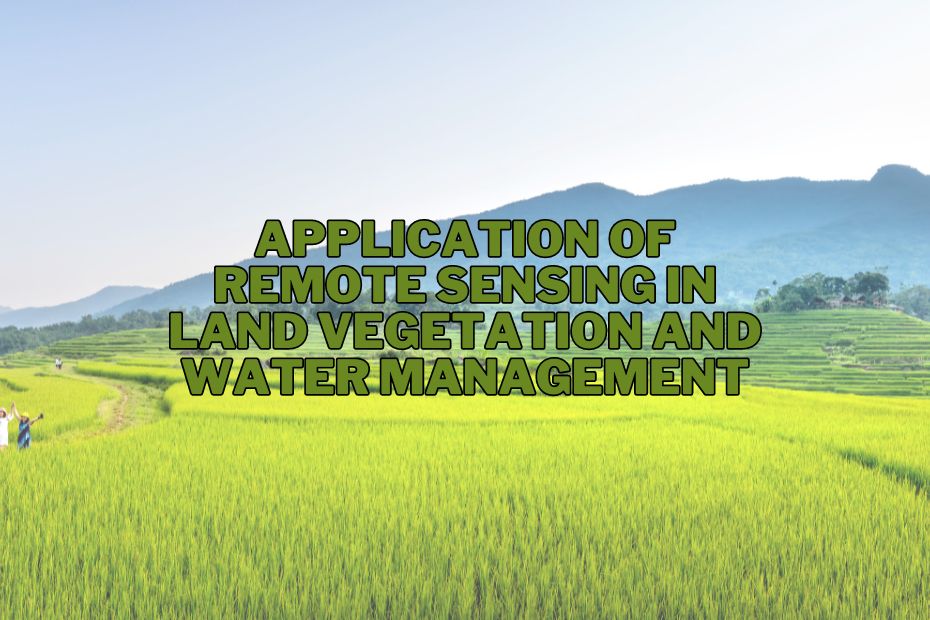Remote sensing technology has revolutionized the way we monitor and manage our natural resources. With its ability to capture data from a distance, it has become an invaluable tool in various fields, particularly in the management of land vegetation and water resources. In this article, we will explore diverse application of remote sensing in land vegetation and water management.
Remote sensing applications in land vegetation and water management encompass precision agriculture, flood monitoring, urban planning, and more. It aids in optimizing crop yields, detecting floods, and conserving ecosystems, making it a vital tool for sustainable resource management.
Application of Remote Sensing In Land Vegetation and Water Management
Remote sensing involves the use of sensors to collect data about objects or areas from a distance. This technology has found numerous applications in land vegetation and water management. Let’s delve into these applications in detail.
1. Agricultural Monitoring
Remote sensing plays a critical role in agricultural monitoring. It enables the analysis of crop health, soil conditions, and water usage, optimizing crop yield and reducing waste. Satellites equipped with remote sensors gather data on vegetation indices, soil moisture levels, and crop stress, providing farmers with actionable insights for better resource management. This technology also aids in predicting crop yields, thus enhancing food security on a global scale.
2. Forest Health Assessment
Forest ecosystems are crucial for biodiversity and climate regulation. Remote sensing aids in assessing forest health by monitoring tree cover, detecting deforestation, and identifying areas affected by pests or diseases. This technology offers a bird’s-eye view, enabling the detection of changes over large areas that would be challenging to monitor on the ground. Such assessments are vital for forest conservation efforts and in combating climate change.
3. Urban Planning and Land Use
The growth of urban areas requires careful planning to ensure sustainable development. Remote sensing assists urban planners in analyzing land use patterns, monitoring urban expansion, and managing natural resources within urban settings. This technology provides detailed imagery and data that help in making informed decisions regarding zoning, infrastructure development, and environmental conservation in urban areas.
4. Drought Detection
Droughts can have devastating effects on agriculture, water supply, and ecosystems. Remote sensing is instrumental in early drought detection by monitoring soil moisture and vegetation health. This early warning system enables governments and communities to implement mitigation strategies, such as water rationing or crop adaptation, to minimize the impact of droughts.
5. Wetland Conservation
Wetlands are vital ecosystems that provide habitat for diverse species and act as natural water filters. Remote sensing aids in wetland conservation by monitoring changes in wetland areas, such as alterations in water levels, vegetation cover, and the impact of human activities. This data is essential for the effective management and protection of these sensitive ecosystems.
6. Water Quality Assessment
Assessing water quality is crucial for human health and environmental protection. Remote sensing technologies, as detailed on Spatial Post, offer a non-intrusive means to monitor water bodies for pollution, algal blooms, and sedimentation. This information is vital for water management authorities to ensure the safety and sustainability of water resources.
7. Flood Prediction and Management
Floods are among the most common natural disasters. Remote sensing contributes to flood prediction and management by providing real-time data on rainfall patterns, river levels, and soil saturation. This data is crucial for early warning systems, helping to mitigate the impact of floods on communities and infrastructure.
8. Geological Exploration
Remote sensing is a key tool in geological exploration. It aids in mapping geological features, identifying mineral deposits, and assessing seismic risks. This technology provides a cost-effective and efficient means to explore and manage geological resources, supporting various industries from mining to construction.
9. Soil Moisture Monitoring
Soil moisture is a critical factor in agriculture, climate studies, and water cycle analysis. Remote sensing provides extensive data on soil moisture levels, enabling better irrigation management and drought prediction. This monitoring is essential for sustainable agricultural practices and effective water resource management.
10. Wildlife Habitat Mapping
The preservation of wildlife habitats is crucial for biodiversity. Remote sensing helps in mapping and monitoring wildlife habitats, identifying threats like deforestation or urban encroachment. This technology offers invaluable data for conservation efforts, ensuring the protection of diverse species and their ecosystems.
11. Invasive Species Detection
Invasive species pose a significant threat to native ecosystems. Remote sensing assists in the early detection and monitoring of invasive species, enabling rapid response and management efforts. This technology is vital for protecting native flora and fauna and maintaining ecological balance.
12. Glacier and Ice Sheet Monitoring
Glaciers and ice sheets are key indicators of climate change. Remote sensing enables the monitoring of changes in these ice masses, providing critical data for climate research. This monitoring is essential for understanding and responding to the impacts of global warming.
Conclusion:
In conclusion, remote sensing is a transformative technology in land vegetation and water management. Its wide range of applications demonstrates its versatility and essential role in environmental monitoring and resource management. As technology advances, its potential in aiding sustainable development and environmental conservation continues to expand.
FAQs: Application of Remote Sensing In Land Vegetation and Water Management
How does remote sensing benefit precision agriculture?
Remote sensing provides data on soil moisture, temperature, and crop health, enabling precise and informed decisions for farmers.
What is the significance of monitoring wetland health?
Monitoring wetland health through remote sensing helps preserve these ecologically sensitive areas and assess the impact of human activities on them.
How does remote sensing aid in disaster management?
Remote sensing technology detects potential disasters like floods, allowing authorities to take proactive measures to minimize damage.
How does remote sensing benefit infrastructure monitoring?
Remote sensing technology helps in the early detection of structural issues in critical infrastructure, ensuring public safety and preventing disasters.
Can remote sensing aid in wildlife conservation?
Yes, it helps in mapping and monitoring wildlife habitats, crucial for conservation efforts and protecting biodiversity.
